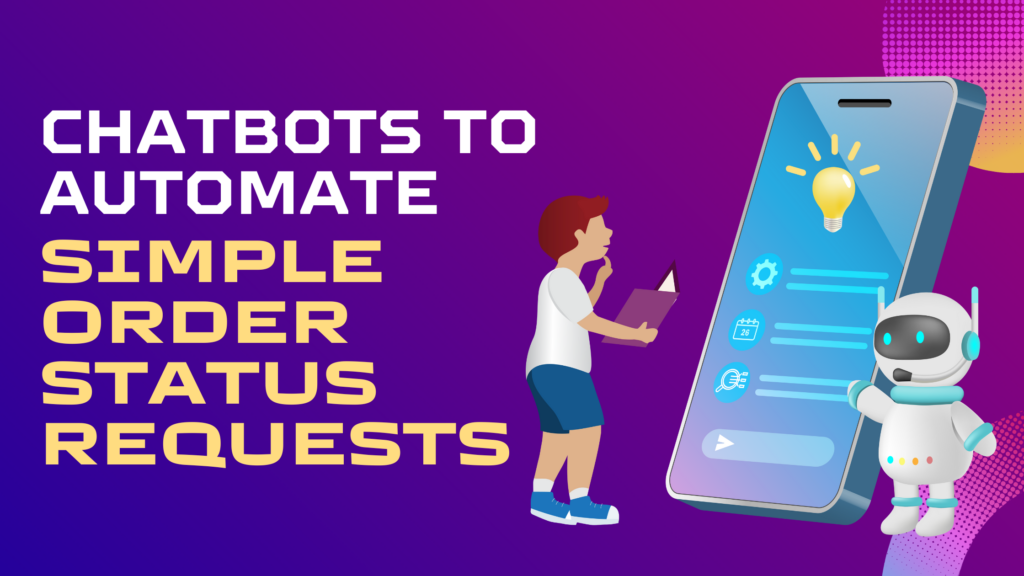Chatbots to Automate Simple Order Status Requests
As online shopping continues to grow, so does the need for efficient and effective customer support. One way retailers are meeting this demand is by using chatbots to handle common inquiries, such as order status requests. By automating these tasks, businesses can free up their human agents to focus on more complex customer issues. In this blog, we will explore how to use chatbots on websites to handle order status inquiries, providing a seamless and convenient experience for customers.
What is a Retail Chatbot?
A retail chatbot is an AI-powered live chat agent that can handle customer inquiries, provide support, and even make product recommendations. These bots are designed to automate simple tasks, such as order tracking, frequently asked questions (FAQs), and basic product recommendations.
By automating these tasks, businesses can save time, scale their customer service, and drive sales. Retail bots can be integrated into various platforms, including social media platforms like Facebook Messenger and Instagram, as well as popular ecommerce providers like Shopify and Salesforce.
The Rise of Chatbots in Retail
Before we dive into the specifics of using chatbots for order status inquiries, let’s take a moment to understand the broader impact of chatbots in the retail industry. Retail bots, powered by artificial intelligence (AI), are revolutionizing customer service and driving sales like never before. These AI-powered chat agents can answer customer questions, provide quick support, and even upsell products online, 24/7.
They bridge the gap between online and offline interactions, improve customer satisfaction, and contribute to higher in-store sales. According to predictions, consumer spending via retail bots is expected to hit a staggering $142 billion USD by 2024, marking a massive 4,971% increase from 2019’s $2.8 billion USD.
Benefits of Using Retail Chatbots for Order Status Inquiries
Using chatbots to automate order status inquiries offers several benefits for both businesses and customers. Let’s explore some of the key advantages:
24/7 Availability: Unlike human agents who have limited working hours, chatbots are available round the clock. This ensures that customers can get instant responses to their order status inquiries, regardless of the time of day.
Instant and Scalable Support: Chatbots can provide instant responses at scale, allowing businesses to handle a high volume of order status inquiries efficiently. This helps improve customer satisfaction and enhances the overall shopping experience.
Frees Up Human Agents: By automating simple tasks like order status inquiries, businesses can free up their human agents to focus on more complex customer issues. This allows the human agents to provide personalized and specialized support, improving the overall quality of customer service.
Consistent and Accurate Information: Chatbots are programmed to provide accurate and up-to-date information. This helps ensure that customers receive consistent and reliable updates on their order status, reducing confusion and frustration.
Improved Efficiency: With chatbots handling order status inquiries, businesses can streamline their customer service operations. This leads to improved efficiency, as bots can handle multiple inquiries simultaneously, reducing wait times for customers.
Best Practices for Implementing Chatbots for Order Status Inquiries
 While chatbots offer numerous benefits, it’s important to implement them effectively to maximize their potential. Here are some best practices for using chatbots to automate order status inquiries:
While chatbots offer numerous benefits, it’s important to implement them effectively to maximize their potential. Here are some best practices for using chatbots to automate order status inquiries:
Choose the Right Chatbot Platform
There are several chatbot platforms available, so it’s essential to choose one that aligns with your business needs. Look for a platform that offers features like easy integration, customizable chat flows, and robust analytics.
Train Your Chatbot
To ensure accurate and helpful responses, train your chatbot with relevant information about your products, order tracking systems, and frequently asked questions. Regularly update and refine the chatbot’s training to improve its performance over time.
Set Clear Expectations
Clearly communicate to customers that they are interacting with a chatbot, not a human agent. Set expectations for response times and let customers know when they can expect to receive updates on their order status.
Provide a Seamless Handoff to Human Agents
While chatbots can handle most order status inquiries, there may be instances where human intervention is necessary. Implement a smooth handoff process to transfer customers to a human agent when needed, ensuring a seamless customer experience.
Continuously Monitor and Optimize
Regularly monitor the performance of your chatbot and analyze customer feedback to identify areas for improvement. Use analytics to track key metrics such as customer satisfaction, response times, and conversion rates.
Real-Life Examples of Chatbots Automating Order Status Inquiries
To illustrate the effectiveness of chatbots in automating order status inquiries, let’s take a look at a few real-life examples:
Fashion Retailer Groupe Dynamite: By implementing an intelligent retail bot like Heyday, Groupe Dynamite saw a significant increase in traffic and chat interactions. The chatbot handled order status inquiries, resulting in improved customer satisfaction and increased sales.
Specialty Food Brand Fody Foods: Fody Foods used retail bots to automate order tracking and other simple customer service inquiries. This allowed their customer service team to save time and focus on more complex issues. The implementation of chatbots resulted in improved efficiency and proactive communication strategies targeted to their specific customer base.
Pizza Chain Domino’s: Domino’s Pizza UK introduced a “Pizza Bot” that allows customers to order pizza through Facebook Messenger. The bot can also access saved “Easy Orders” and complete the order process with a single tap. By automating the ordering process, Domino’s improved customer satisfaction and experienced significant sales growth.
Conclusion
Chatbots have become an indispensable tool for retailers looking to provide efficient and effective customer service. By automating order status inquiries, businesses can save time, scale their customer support, and enhance the overall shopping experience. Implementing chatbots requires careful consideration of the right platform, training the chatbot, setting clear expectations, providing seamless handoffs to human agents, and continuously monitoring and optimizing performance.
Real-life examples demonstrate the success of chatbots in automating order status inquiries and improving customer satisfaction. Embracing chatbot technology can help retailers stay ahead in a competitive market and deliver exceptional customer service. So, why wait? Start using chatbots to automate your order status inquiries and unlock the full potential of your customer support.




